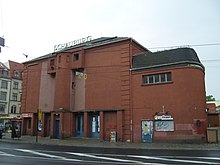Schauburg (Dresden)
The Schauburg film theater is a traditional cinema in Dresden that has existed since 1927 with around 800 seats in five halls and is a member of the working group Kino - Gilde deutscher Filmkunsttheater .
Location
The Schauburg is located in the Äußere Neustadt at the intersection of Königsbrücker Straße and Bischofsweg.
description
The “temple front” of the Hellerau Festival Hall became the model for many modern buildings in the 1920s. The Schauburg film theater also has a “simplified temple front”. This temple front is formed by the pylons at the exit. "Cornices, corner blocks, the framing of larger areas and the pylons at the exit (as a simplified temple front) appear neoclassical". The building is compact with a flat hipped roof and is now colored English-red.
history
The Schauburg was built in the golden twenties according to the plans of the architect Martin Pietzsch . The opening of this first free-standing cinema in Dresden took place on October 15, 1927. The cinema consisted of only one hall with 1000 seats until after the Second World War and had a cinema organ typical of the silent film era .
The cinema was spared from the air raids on Dresden in 1945. For a year it was then used as a venue for the Sarrasani Circus , whose house had been destroyed in the war. In addition, various political events took place, such as the founding meeting of the Free German Trade Union Federation for Dresden and Saxony in July 1945, a large-scale rally by the SPD on July 29, and the opening of a “culture week” for Saxony in March 1946.
On June 3, 1946, the reopening of the cinema took place under the leadership of the Soviet film distributor Sojusintorgkino (Russian Союзинторгкино). The first film shown was Stormy Retirement . Fritz Seidel also played the Hupfeld organ and Herbert Ernst Groh sang arias and songs accompanied by the pianist Bernhard Derksen.
In 1953 the SG Dynamo Dresden was founded in the Schauburg.
Until the opening of the round cinema in 1972, the Schauburg was Dresden's largest cinema and at the same time the site of the city's premieres. After the fall of the Wall , it belonged to Neue Constantin Film GmbH until it was temporarily closed in 1992 . On May 5, 1994, the Schauburg reopened after extensive renovation. The owner has been Kieft und Kieft GmbH since then.
The cinema had to start rebuilding in 2017 three rooms and a bistro in the foyer.
Present and plans
With an alternative cinema program, the Schauburg has been able to hold its own against the large multiplex cinemas in Dresden, with visitor numbers that have remained constant since 1998 . The cinema is operated by Nickelodeon FTB Dresden GmbH.
Since the renovation planned by the Dresden office GNbh Architekten Grill & Neumann Partnerschaft, the Schauburg has more than 800 indoor seats. After a renovation phase of eleven months, it resumed operations with a partial opening; all five halls have been in use since October 2018. The last work is currently (April 2019) taking place in the open-air cinema in the courtyard.
Individual evidence
- ↑ Lupfer, No. 171 (Schauburg Filmtheater, Königsbrücker Straße 55, 1927-28, Martin Pietzsch)
- ↑ Sandro Rahrisch: The Schauburg after the Second World War . In: Saxon newspaper . April 13, 2016.
- ↑ Sandro Rahrisch: New start with screen propaganda . In: Saxon newspaper . April 13, 2016.
- ↑ Imprint on schauburg-dresden.de
literature
- Frank Apel: Dresden cinema culture in the seventies and eighties. In: Dresdner Hefte 82, Dresdner Geschichtsverein eV, 2005, ISBN 3-910055-76-1 .
- Gilbert Lupfer, Bernhard Sterra, Martin Wörner (eds.): Architecture guide Dresden. Dietrich Reimer Verlag, Berlin 1997, ISBN 3-496-01179-3 .
Web links
Coordinates: 51 ° 4 ′ 16.5 ″ N , 13 ° 45 ′ 0 ″ E


